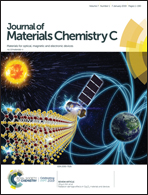How to predict the location of the defect levels induced by 3d transition metal ions at octahedral sites of aluminate phosphors†
Abstract
How the 3d transition metal (TM) ions induce defect levels in wide band gap compounds and how these defect levels evolve from compound to compound is very important in understanding and predicting the luminescent properties of TM activated phosphors. This issue is discussed by studying the ground state 3dn level locations of the TM impurity ions (Sc–Zn) incorporated at the octahedral sites of many oxides. These ground state 3dn level locations are obtained by collecting the CT bands from the literature of the past 50 years and also by first-principles calculations. By taking the vacuum level as the reference, we scaled all the locations of the TM ion in 3+ and 2+ states and constructed a zig-zag-curve scheme in α-Al2O3 through connecting the 3dn ground state energies of Sc to Zn. The scheme can be extended to other aluminates easily and so offers a first estimate on where TM levels are located in compounds without complicated theoretical calculations. The estimate can be improved to a higher accuracy if the position of the valence band is known. Our work provides new insights for understanding the luminescent behavior of 3d-TM doped phosphors and may aid in developing 3d ion doped functional materials further.



 Please wait while we load your content...
Please wait while we load your content...